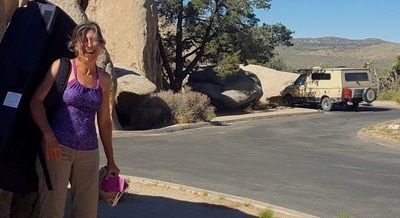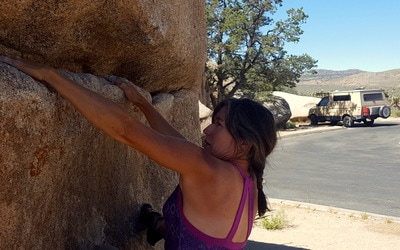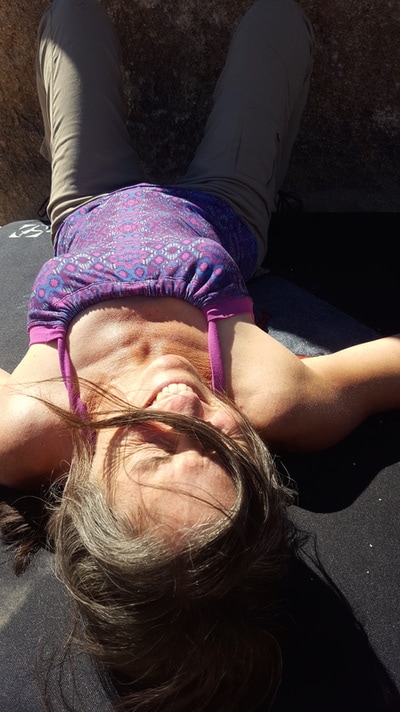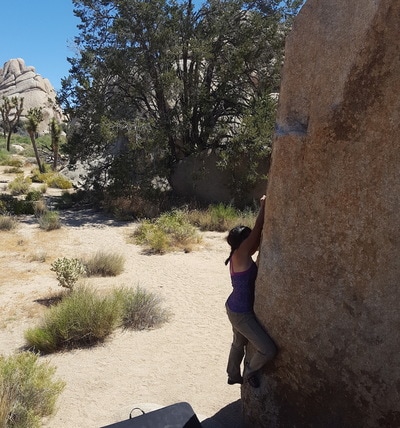This is a story of buts. I have been climbing for about 10 years now and intending to boulder for most of those years. But, other than the occasional gym session, I found reasons not to foray into pebble wrestling:
As a lover of rock climbing I appreciated bouldering and those who can do it and I wanted to experience bouldering’s own uniqueness. But, I told myself, I experience uniqueness on each new type of rock, in each new area I explore, on climbs I have never done before. So, I stayed on rope.
I knew of the benefits of bouldering to round out the rock-climbing repertoire. I heard from so many other rope-based climbers it will strengthen my climbing. But, I told myself, I can also be a stronger climber if I just climb harder routes. So, I stayed on rope.
But, in this story of buts, I finally did it. I finally crossed the line: I bought a bouldering pad and bouldered outdoors (attempted may actually be a more accurate description). And it was FUN! And DIFFICULT! And, I WANT TO DO IT AGAIN.
First, here is what I particularly loved about this bouldering experience:
So, if bouldering has all of these awesome benefits, what took me so long? What was it that finally pushed me over the edge?
Joshua Tree.
Joshua Tree did it.
More specifically, the heinous, nasty, exposed, long, dead-end-filled, boulder-strewn approaches to many climbs at Joshua Tree did it. I have done WAY too many of these approaches because my husband and I are mapping climbing approaches and walk-offs for Joshua Tree (for our company Climb-On Maps).
Yes, of course, there are short approaches to climbs in Joshua Tree, but unless there are rap anchors (which you generally cannot count on), then you have to walk-off, which, 95% of the time means navigating a boulder field... If you aren't dealing with boulderfields day in and day out, it's not that big of a deal, but for our circumstances, hell no, I ain't doing that for fun.
I also didn't feel like spending hours combing the guidebooks to find the perfect climb combination - short approach, good protection, a grade I felt like climbing, a style I felt like climbing...etc.
But we wanted to climb. We needed to climb. Fun climb. One day while mapping it hit us like a ton of bricks – we noticed the bouldering-boulders were almost always close to the car and were on the desert floor – i.e. The approach was easy - SUPER easy. BINGO and VIOLA! We were going bouldering.
So this brings me to my final bullet point highlighting what I loved about this boudering experience:
- I need to keep my lead-head on; I don’t want to tweak a tendon, twist and ankle, <<insert random injury fear excuse>>; I love getting high (gaining altitude, that is) with the protection of a rope; I love the adventure of trad climbing; bouldering is difficult, different, gonna kick my ass, <<insert random ego-wound-licking excuse here>>.
As a lover of rock climbing I appreciated bouldering and those who can do it and I wanted to experience bouldering’s own uniqueness. But, I told myself, I experience uniqueness on each new type of rock, in each new area I explore, on climbs I have never done before. So, I stayed on rope.
I knew of the benefits of bouldering to round out the rock-climbing repertoire. I heard from so many other rope-based climbers it will strengthen my climbing. But, I told myself, I can also be a stronger climber if I just climb harder routes. So, I stayed on rope.
But, in this story of buts, I finally did it. I finally crossed the line: I bought a bouldering pad and bouldered outdoors (attempted may actually be a more accurate description). And it was FUN! And DIFFICULT! And, I WANT TO DO IT AGAIN.
First, here is what I particularly loved about this bouldering experience:
- The equipment was so fricking light! Despite the fact that you are carrying a huge Sponge Bob Square Pants wind-catching mattress on your back, the equipment is not heavy. You aren’t carrying 50 pounds of rope, helmet, harness, carabiners, webbing, nuts, cams, water, food, clothing... Awesome!
- I remained close to the ground. I know, I know, earlier in this article I said I love getting high. I do. But when not protected by rope, I dig the safety of being close to the ground. Admittedly, at first, when I grabbed the lip of rock for a bouldering traverse climb and my feet were less than 3 inches from la tierra firma, I laughed. A weird part of me first thought “this is not rock climbing.” But, of course it is and, of course, the goal is to keep your feet on the rock. Considering the lack of footholds and the angle of my crunched-up body relative to the crack, that wasn’t so easy.
- Bouldering was difficult. I know, I know, earlier in this article I said I was concerned about the difficulty of bouldering. And, yes, admittedly, part of me is still not crazy about the feeling that I am essentially starting from scratch with a sport I have been doing actively for 10 years. But, it is the concentrated difficulty of bouldering, use of techniques, and body-angles that will also improve my overall climbing.
- It took 30 seconds to set up and get climbing. The set-up was so freaking easy it’s laughable. Drop pad, open pad, put on shoes, chalk up, go. Compare that to setting up for a trad climb: Drop huge backpack possibly near the base of the climb, or possibly in a different location depending on the walkoff; pull gear out of bag; put on harness; flake rope (or sort rope for a shoulder-carry, if the approach continues); sort rack to make sure you add/remove pieces you need/don’t need and the remaining pieces are in the order you want them; sort webbing, runners, etc. and carabiners to ensure you have all the alpine draws and anchor materials you need; pull out small summit pack and fill with jacket/snacks/water/phone/emergency beacon/walk-off shoes, etc.; put on climbing shoes; put on summit pack; load gear on harness, across chest, onto body as needed; tie into the rope; do buddy checks; climb. There is a lot to love about the simplicity of bouldering.
So, if bouldering has all of these awesome benefits, what took me so long? What was it that finally pushed me over the edge?
Joshua Tree.
Joshua Tree did it.
More specifically, the heinous, nasty, exposed, long, dead-end-filled, boulder-strewn approaches to many climbs at Joshua Tree did it. I have done WAY too many of these approaches because my husband and I are mapping climbing approaches and walk-offs for Joshua Tree (for our company Climb-On Maps).
Yes, of course, there are short approaches to climbs in Joshua Tree, but unless there are rap anchors (which you generally cannot count on), then you have to walk-off, which, 95% of the time means navigating a boulder field... If you aren't dealing with boulderfields day in and day out, it's not that big of a deal, but for our circumstances, hell no, I ain't doing that for fun.
I also didn't feel like spending hours combing the guidebooks to find the perfect climb combination - short approach, good protection, a grade I felt like climbing, a style I felt like climbing...etc.
But we wanted to climb. We needed to climb. Fun climb. One day while mapping it hit us like a ton of bricks – we noticed the bouldering-boulders were almost always close to the car and were on the desert floor – i.e. The approach was easy - SUPER easy. BINGO and VIOLA! We were going bouldering.
So this brings me to my final bullet point highlighting what I loved about this boudering experience:
- The approach was about as easy as it gets! We literally parked the car and walked about 100 feet to the first boulder, then 100 feet to the next boulder, then a few hundred feet to the next boulder. Sweeeet! See the photos below? On the left, that's me joyous at the ease of the approach. The second one is me bouldering with our van in the background.
Because we A NOTE ON BOULDERING IN JOSHUA TREE: JTree has a ton of bouldering with really easy access. Many of the boulders are slopey and slabby, but there are plenty of flakes, cracks, featured faces, aretes, etc. to keep it interesting for a long time. In addition, there are so many boulders that if you are willing to walk out into the desert a bit, there are likely many first ascents to be had.
Joshua Tree Bouldering Books
A NOTE ON USING CLIMB-ON MAPS TO PLAN CLIMBING: One of the unique features of Climb-On Maps is that it can be used as a planning tool for climbing. At a glance you will be able to see the total number of climbs on a wall, the distribution of grades and types of climbs (e.g. trad, sport, top rope), and the length and difficulty level of an approach.
Joshua Tree Bouldering Books
- Joshua Tree Bouldering, By Robert Miramontes
A NOTE ON USING CLIMB-ON MAPS TO PLAN CLIMBING: One of the unique features of Climb-On Maps is that it can be used as a planning tool for climbing. At a glance you will be able to see the total number of climbs on a wall, the distribution of grades and types of climbs (e.g. trad, sport, top rope), and the length and difficulty level of an approach.




